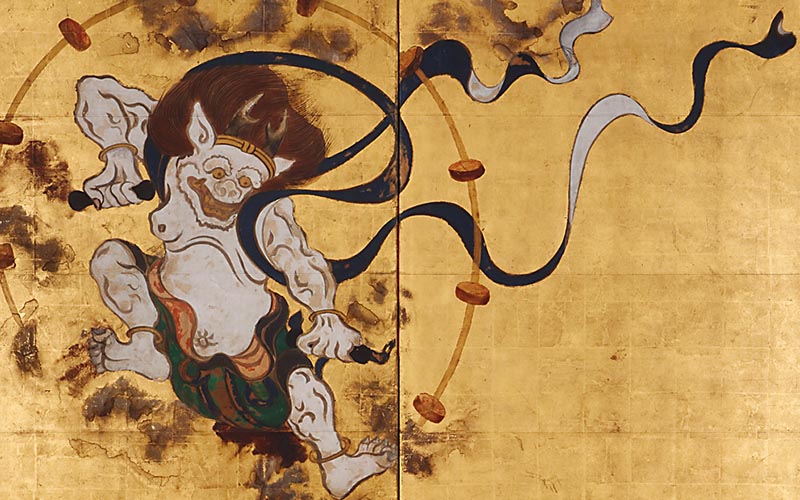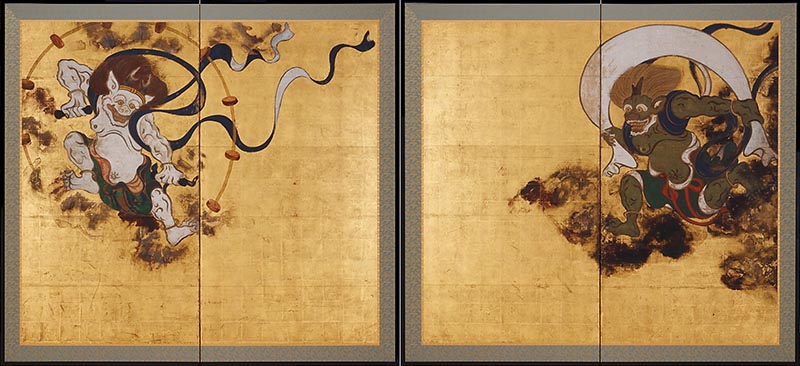
Tawaraya Sotatsu, Master of Japanese Art
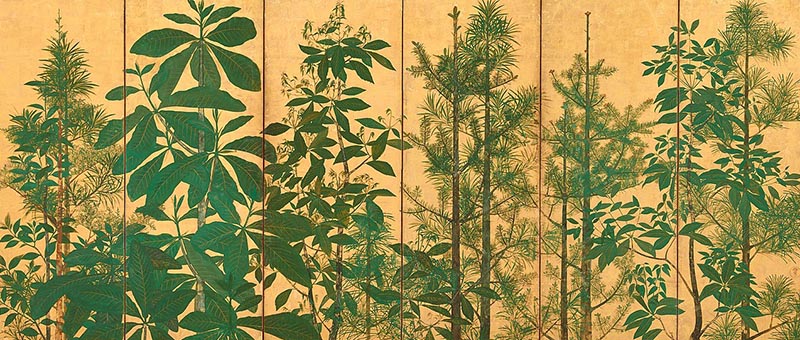
Tawaraya Sotatsu was a painter active in Kyoto in the early Edo period. He excelled at elegant and decorative paintings, making full use of the beauty of gold and silver leaf margins and the Japanese painting technique known as “Tarashikomi”.
Sotatsu pursued his own style of painting without belonging to any particular school, and as a “pioneer of the Rinpa school”, he had a great influence on later artists such as Ogata Korin. One of his representative works is “Fuji Raijin Zu Byobu” (Wind God and Thunder God).
Biography of Tawaraya Sotatsu

Tawaraya Sotatsu’s biography is unclear, and his detailed birth and death dates are also unknown. It is believed that he may have been born in the 1570s and died before 1650.
Tawaraya Sotatsu, who worked as a painter, founded his class in the city of Kyoto. And at his workshop named “Tawaraya”, he mainly undertook “Ogi-e” (fan paintings), “Byobu-e” (folding screen paintings), and a rough sketch on Japanese paper called “ryoshi”, which was dyed in colors and decorated with gold and silver. His skills were recognized at the time as “a first-rate, beyond the level of a town painter”, and according to the Kana Zoshi “Chikusai”, a picture shop “Tawaraya” in Kyoto was very reputable.
Sotatsu was a close friend of cultured people such as Hon’ami Koetsu and the tea ceremony Sen no Shoan, and his abilities were recognized by the upper classes and wealthy people. He was given the high rank of “Hokkyo”, which is given to priests, and worked on supplementary works for the “Heike Nokyo” and a rough sketch for Koetsu’s calligraphy, and received an order for a gold folding screen from Gosui Tenno.
Sotatsu, who did not belong to any particular school such as the Kano or Tosa schools, but worked freely, produced works in a variety of genres, from waka scrolls and ink paintings to Byobu-e (folding screen paintings) with skillful gold and silver designs.
Tawaraya Sotatsu’s masterpiece
Tawaraya Sotatsu “Fuji Raijin Zu Byobu” (Wind God and Thunder God)

“Fuji Raijin Zu Byobu” (Wind God and Thunder God) by Tawaraya Sotatsu is Byobu-e depicting a somewhat humorous scene of a clash between the wind god holding a windbag and the thunder god carrying a drum. The composition is characterized by the exquisite balance of the two deities being drawn so large that the corners are cut off, while leaving the center blank, and the clouds on which the wind and thunder gods ride are drawn in a “tarashikomi”.
Although there is no signature nor seal of Sotatsu in “Fujin Raijin Zu Byobu”, it is instantly recognizable as a work by him, and can be considered a masterpiece of Japanese art.
“Fujin Raijin Zu Byobu” is designated as a National Treasure. ★30
Tawaraya Sotatsu “Renchi Suikin Zu” (Waterfowls in Lotus Pond)
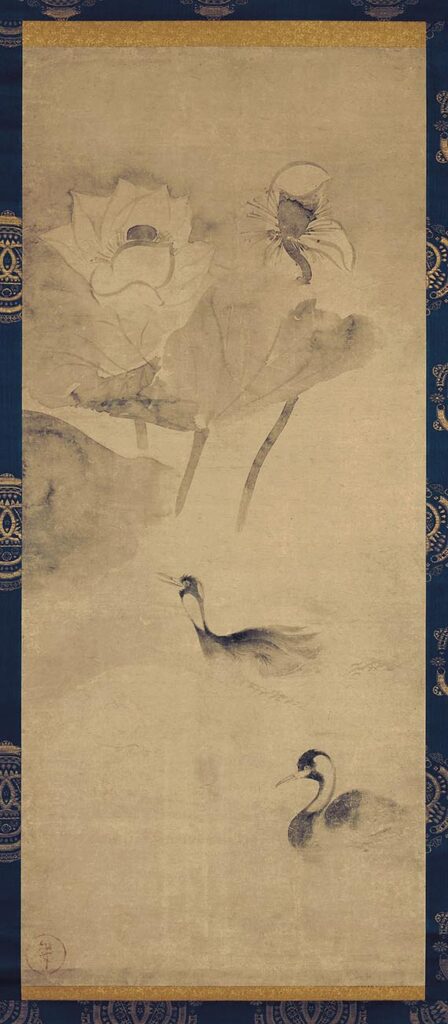
Tawaraya Sotatsu “Renchi Suikin Zu” (Waterfowls in Lotus Pond) is Suiboku-ga (ink painting) depicting a lotus pond with two flowers and two kites floating in it. Sotatsu made full use of the tarashikomi technique to depict the water in the pond, the rising steam, the light, and even the colors, all in shades of black ink. In contrast to the Suiboku-ga of Sesshu and Sesson, this painting has no straight lines and has a soft, emotional atmosphere.
“Renchi Suikin Zu” is designated as a National Treasure.
Tawaraya Sotatsu “Bugaku Zu”(Bugaku Dance)
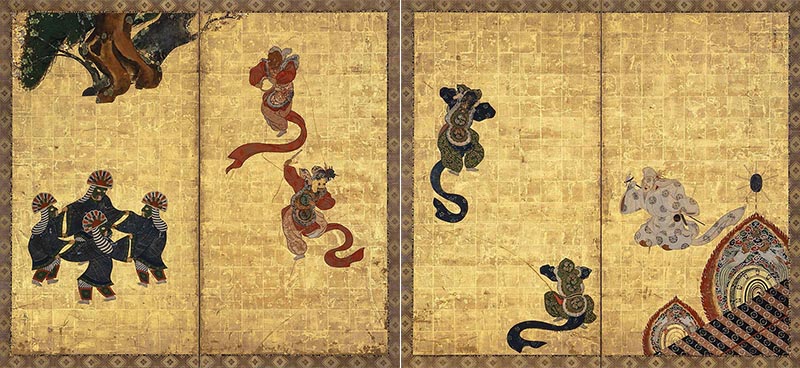
Tawaraya Sotatsu “Bugaku Zu” (Bugaku Dance) is Byobu-e with a design of joyful dancers on a flat gold background, composed from a high, bird’s-eye view. From right to left are depicted Saisoro, Nasori, Ranryo-Ou, Genjoraku, and Hassen, with a drum peeking out from a curtain cut off in the lower right corner. Sotatsu’s skill in careful composition and placement shines through in this work.
“Bugaku Zu” is designated as a National Important Cultural Property of Japan.
Popularity and Features of Tawaraya Sotatsu
Shading of sumi ink “Tarashikomi”

“Tarashikomi” in the paintings of Tawaraya Sotatsu is a technique unique to Japanese-style painting in which ink is applied to Japanese paper or silk before it dries, and then more ink is applied on top of the ink to create an expression that makes the most of the blotches and shading of the ink.
Sotatsu is said to have started this technique. He used tarashikomi not only in Suiboku-ga but also in gold and silver Byobu-e, establishing his own style of painting.
Tawaraya Sotatsu, the founder of Rin school
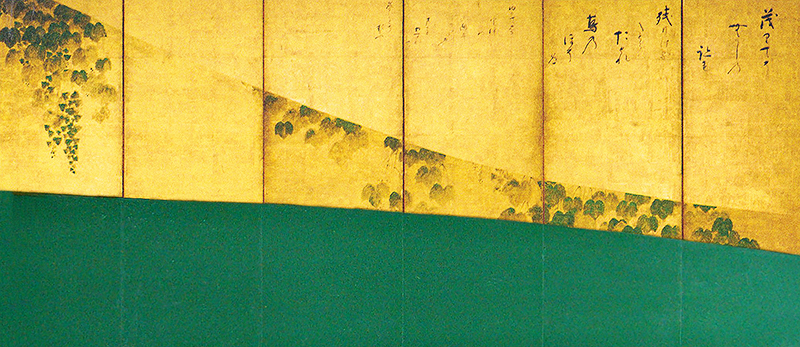
Tawaraya Sotatsu excelled at creating original expressions using the tarashikomi technique and highly decorative works with gold and silver backgrounds.
The talent of Sotatsu, who established his own style of painting without belonging to any particular school, was inherited by painters such as Ogata Korin and Sakai Hoitsu.
An aesthetic of blank spaces, fusion of design and painting

Tawaraya Sotatsu’s paintings are characterized by an aesthetic of blank spaces. Sotatsu, who excelled at softly curved “Kacho-ga” (flower-and-bird paintings) and “Fukei-ga” (landscapes), was particular about the aesthetics of margins and subtraction. He would cut off an object at the corner of a folding screen or fan to let the viewer imagine the world outside, or he would intentionally paint an object small to leave a lingering impression against a gorgeous gold or silver background.
Sotatsu was a painter who pursued ways to enhance the impression of his works by making the most of margins.
Co-creation like music with pictures and text
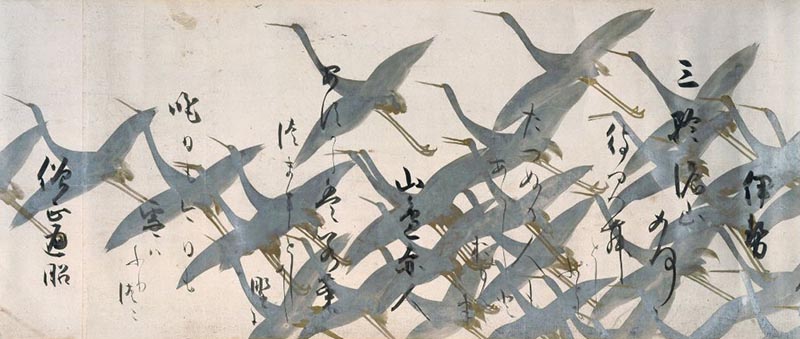
Tawaraya Sotatsu brought a new style to Japanese art while also contributing to the revival of the classics.
Sotatsu was discovered as a production partner by Hon’ami Koetsu, who was a close friend of Sotatsu. They collaborated on such works as “Shiki Soka Shita-e wakakan” which features a series of bamboo, plum blossoms, and ivy in Hon’ami Koetsu’s calligraphy, and “Tsurushita-e sanjuroku kasen wakakan”, which features flying cranes made of gold and silver.
Sotatsu’s rough sketch, which is soft and noisy, has a life force as if it were playing music with the calligraphy.
Tawaraya Sotatsu’s influence and reputation
Tawaraya Sotatsu’s reputation in Japan

Tawaraya Sotatsu’s painting style and techniques were inherited by later Rimpa school painters such as Ogata Korin and Sakai Hoitsu, who were highly regarded for their abilities and produced many outstanding works from the Edo period. Tawaraya Sotatsu, who is called the founder of the Rimpa school, is still highly regarded today for his expressive style and design.
Even overseas, “Fujin Raijin Zu Byobu” is widely known as a masterpiece of Japanese art, and Sotatsu’s artistry is highly acclaimed.
Tawaraya Sotatsu’s influence
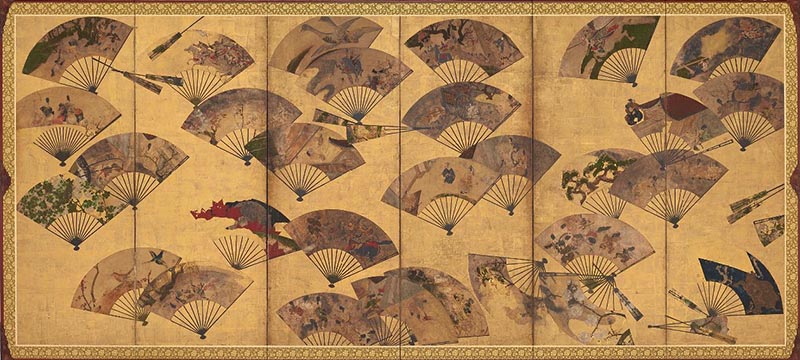
Tawaraya Sotatsu created many works that are representative of Japanese art, including “Fujin Raijin Zu Byobu”. Today, many reproductions of “Fujin Raijin Zu Byobu” and homages to his works continue to be created.
Sotatsu’s aesthetics of blank spaces, the beauty of curves, and his pictorial expression in terms of design are also relevant to contemporary design, and it can be said that he was a highly influential artist.
Summary of Tawaraya Sotatsu
Tawaraya Sotatsu was a popular painter in Edo who was also commissioned by the Tokugawa family and the Imperial Court. He established a unique style of painting with his “tarashikomi” technique and his effective use of margins, and as the founder of the Rimpa school, he had a profound influence on Japanese painting and crafts.
Tawaraya Sotatsu’s artistry, which combined classical Japanese beauty with new techniques, has left a significant mark on Japanese culture and art.
